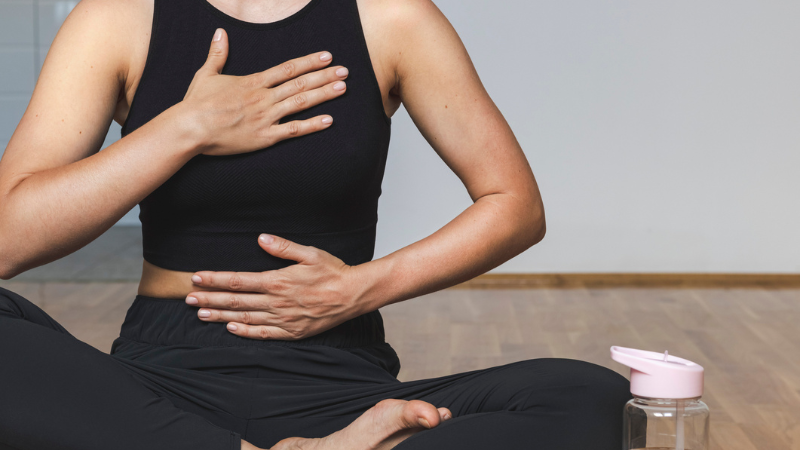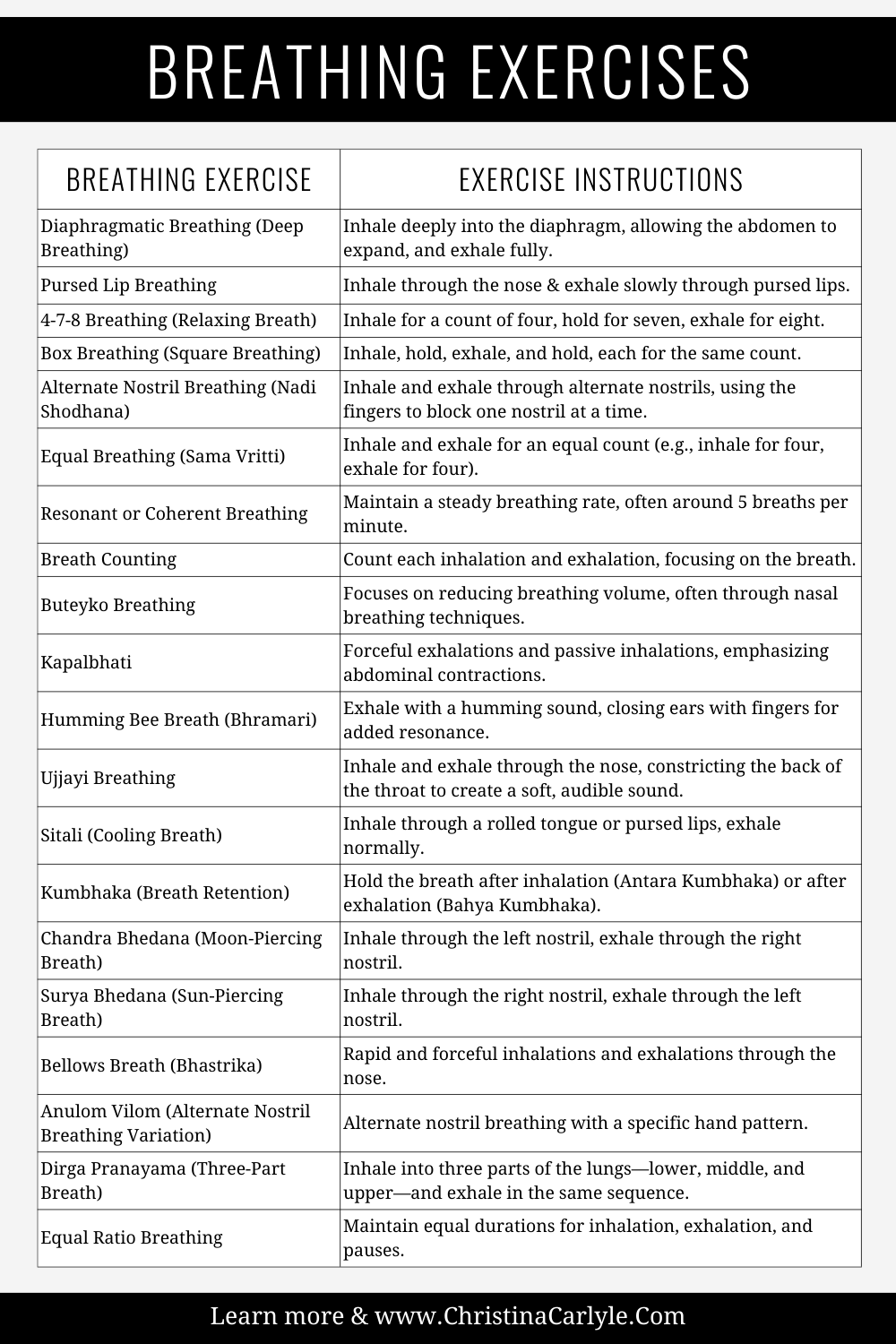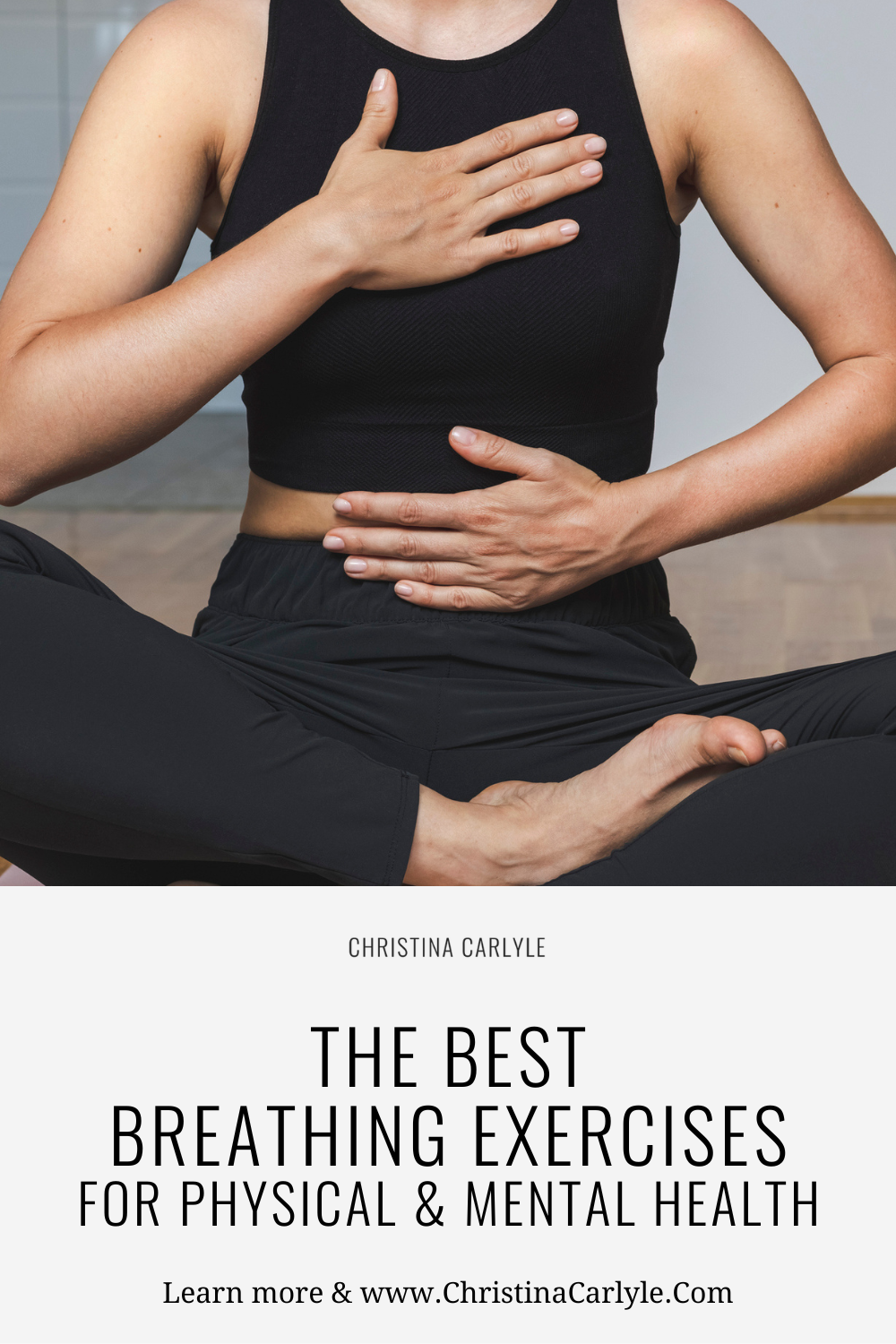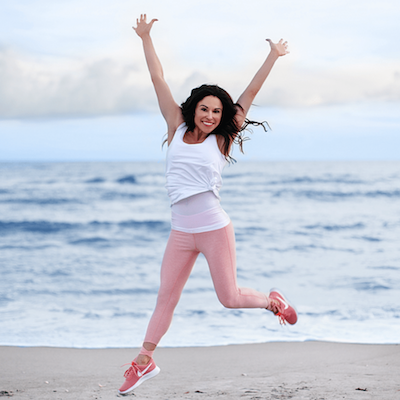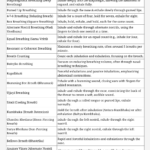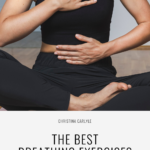Last Updated on January 22, 2024
Breathing exercises are techniques that focus on controlling and manipulating one’s breath to achieve specific physical, mental, or emotional outcomes. These exercises often involve conscious regulation of inhalation, exhalation, and sometimes breath retention.
These exercises can have various effects, such as reducing stress, improving focus, enhancing lung capacity, promoting relaxation, and supporting overall well-being. Different techniques may be suitable for different situations or desired outcomes, and it’s essential to practice them with mindfulness and awareness.
I’ve been studying holistic health and healing modalities for the past 5 years. Out of everything I’ve learned, I’ve found breathing exercises to be the easiest, most effective thing that helps my energy, mood, and stress levels, and to cope whenever I need it.
There are a TON of different techniques you can do.
Choose your favorite then do it whenever you need to.
Different Breathing Techniques
Here are some common types of breathing exercises that you can use to boost your physical and mental health:
Diaphragmatic Breathing (Deep Breathing):
- Exercise: Inhale deeply into the diaphragm, allowing the abdomen to expand, and exhale fully.
- Benefits: Promotes relaxation, reduces stress, and encourages efficient breathing.
Pursed Lip Breathing:
- Exercise: Inhale through the nose and exhale slowly through pursed lips.
- Benefits: Improves breathing efficiency, particularly beneficial for individuals with respiratory conditions.
4-7-8 Breathing (Relaxing Breath):
- Exercise: Inhale for a count of four, hold for seven, exhale for eight.
- Benefits: Facilitates relaxation, aids in stress reduction, and promotes better sleep.
Box Breathing (Square Breathing):
- Exercise: Inhale, hold, exhale, and hold, each for the same count.
- Benefits: Enhances relaxation, fosters focus, and helps regulate breathing patterns.
Alternate Nostril Breathing (Nadi Shodhana):
- Exercise: Inhale and exhale through alternate nostrils, using the fingers to block one nostril at a time.
- Benefits: Balances brain hemispheres, reduces stress, and enhances mental clarity.
Equal Breathing (Sama Vritti):
- Exercise: Inhale and exhale for an equal count (e.g., inhale for four, exhale for four).
- Benefits: Promotes calmness, improves focus, and maintains emotional balance.
Resonant or Coherent Breathing:
- Exercise: Maintain a steady breathing rate, often around 5 breaths per minute.
- Benefits: Balances the autonomic nervous system, reduces stress, and enhances overall well-being.
Breath Counting:
- Exercise: Count each inhalation and exhalation, focusing on the breath.
- Benefits: Acts as a mindfulness exercise, promoting present moment awareness and concentration.
Buteyko Breathing:
- Exercise: Focuses on reducing breathing volume, often through nasal breathing techniques.
- Benefits: Aims to improve oxygenation, respiratory function, and overall well-being.
Kapalbhati:
- Exercise: Forceful exhalations and passive inhalations, emphasizing abdominal contractions.
- Benefits: Cleanses the lungs, energizes the body, and enhances mental alertness.
Humming Bee Breath (Bhramari):
- Exercise: Exhale with a humming sound, closing ears with fingers for added resonance.
- Benefits: Calms the nervous system, reduces stress, and aids in meditation.
Ujjayi Breathing:
- Exercise: Inhale and exhale through the nose, constricting the back of the throat to create a soft, audible sound.
- Benefits: Enhances concentration, warms the body, and promotes mindfulness in yoga.
Sitali (Cooling Breath):
- Exercise: Inhale through a rolled tongue or pursed lips, exhale normally.
- Benefits: Cools the body, calms the mind, and may reduce stress.
Kumbhaka (Breath Retention):
- Exercise: Hold your breath after inhalation (Antara Kumbhaka) or after exhalation (Bahya Kumbhaka).
- Benefits: Enhances lung capacity, builds respiratory endurance, and supports meditation.
Chandra Bhedana (Moon-Piercing Breath):
- Exercise: Inhale through the left nostril and exhale through the right nostril.
- Benefits: Cools and calms the body, reducing heat and stress.
Surya Bhedana (Sun-Piercing Breath):
- Exercise: Inhale through the right nostril and exhale through the left nostril.
- Benefits: Energizes and warms the body, promoting alertness.
Bellows Breath (Bhastrika):
- Exercise: Rapid and forceful inhalations and exhalations through the nose.
- Benefits: Invigorates the body, increases energy levels, and enhances mental clarity.
Anulom Vilom (Alternate Nostril Breathing Variation):
- Exercise: Alternate nostril breathing with a specific hand pattern.
- Benefits: Balances energy flow, reduces stress, and enhances focus.
Dirga Pranayama (Three-Part Breath):
- Exercise: Inhale into three parts of the lungs—lower, middle, and upper—and exhale in the same sequence.
- Benefits: Improves lung capacity, enhances oxygenation, and promotes relaxation.
Equal Ratio Breathing:
- Exercise: Maintain equal durations for inhalation, exhalation, and pauses.
- Benefits: Maintains emotional balance, enhances focus, and encourages a rhythmic breath pattern.
Now that you know the different types of breathing exercises, here’s a list of good reasons why you should do them all the time.
Breathwork Benefits
Breathwork offers a variety of physical, mental, and emotional benefits. Here are the top reasons why someone might choose to engage in breathwork practices:
Stress Reduction:
- Breathwork is known to activate the body’s relaxation response, leading to a reduction in stress levels. Deep breathing and relaxation techniques can help calm the nervous system and alleviate the effects of stress.
Improved Mental Focus and Clarity:
- Certain breathing exercises, such as deep diaphragmatic breathing and mindfulness-based techniques, can enhance concentration and mental clarity. They help individuals become more present and focused on the current moment.
Emotional Regulation:
- Breathwork can be a powerful tool for emotional regulation. Techniques like deep breathing and alternate nostril breathing may help individuals manage and balance their emotions.
Enhanced Respiratory Function:
- Specific breathwork exercises are designed to improve lung capacity, respiratory efficiency, and overall respiratory health. This can be particularly beneficial for individuals with respiratory conditions or those seeking better athletic performance.
Improved Sleep Quality:
- Relaxation-oriented breathwork techniques, such as the 4-7-8 breathing method, are known for their calming effects and may contribute to better sleep quality. Practicing breathwork before bedtime can promote relaxation and ease insomnia.
Enhanced Physical Performance:
- Athletes often use breathwork to optimize physical performance. Techniques like rhythmic breathing and breath control can help improve endurance, stamina, and recovery.
Mindfulness and Meditation:
- Breathwork is a fundamental aspect of many mindfulness and meditation practices. Focusing on the breath helps individuals cultivate present-moment awareness, reduce mental chatter, and deepen their meditation experience.
Support for Anxiety and Depression:
- Some breathwork techniques, including coherent breathing and slow-paced breathing, have been shown to have a positive impact on symptoms of anxiety and depression. They can contribute to a sense of calm and well-being.
Energizing and Invigorating:
- Certain breathwork practices, such as Kapalbhati and Bhastrika, involve rapid and forceful breathing that can energize the body, increase alertness, and enhance mental clarity.
Spiritual Exploration:
- Breathwork is sometimes used as a tool for spiritual exploration and self-discovery. Techniques like holotropic breathwork may be employed in therapeutic or spiritual contexts to induce altered states of consciousness.
Coping with Pain or Discomfort:
- Breathwork can be used as a complementary approach to manage pain or discomfort. Techniques like focused breathing and visualization may help individuals cope with physical sensations.
Breathing exercises are one of the easiest and best things you can do for your physical and mental health so give them a try and leave me a comment to let me know which exercise you like best.
Your Coach and Biggest Cheerleader,
![]()
P.S. If you’ve been stressed for a while or have physical/mental health issues then you should try my Magic Moves Somatic Exercise Program.
This program combines somatic exercises, yoga, and breathing exercises to balance the nervous system & hormones. The moves really help reduce stress, tension, and blocks that make it hard to lose weight & feel good.
Magic Moves participants lose an average of 3 pounds their first week without changing their diet/exercise habits.

